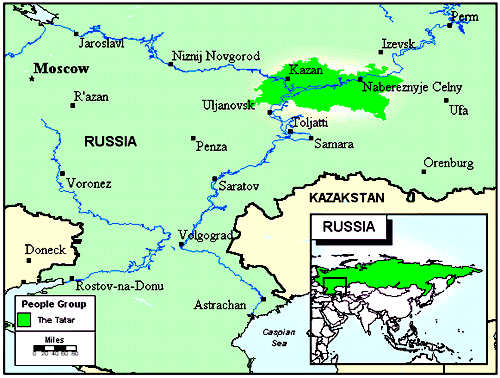|
|
Prayer Profile
The Tatar of Russia
![[IMAGE]](../images4/0689.jpg) The Tatar are a group of Turkic people who have substantial colonies in virtually every republic of the former Soviet Union. While the main population is centered around the Volga region, some also live in many of the Central Asian republics.
The Tatar are a group of Turkic people who have substantial colonies in virtually every republic of the former Soviet Union. While the main population is centered around the Volga region, some also live in many of the Central Asian republics.
The physical appearance of the Tatar varies from blue-eyed blondes to more Mongoloid features. In general, they have oval faces with little facial hair. They speak a unique language called Kazan Tatar, although many now claim Russian as their mother tongue. They are a settled people, mostly peasants and merchants, who have completely lost their traditional tribal structure.
The Tatar have had a strongly urbanized civilization since the tenth century. It has survived both the Mongol invasion of the thirteenth century and the Russian conquest of the sixteenth century. In the 1800's, Tatar cities ranked among the greatest cultural centers of the Islamic world.
What are their lives like?
The Tatar often seek work outside their native region, following a trend of mobility established before 1917. Some work in Russian manufacturing industries and petroleum refineries. Many of those in the Volga region work on "collective" (community) farms where they raise grains, hemp, legumes, and other fodder crops.
In urban areas, the Tatar live no differently than modern Russians. However, those living in rural areas still hold to their pre-Revolutionary traditions. For example, up to three generations may live under one roof. Today, there are no villages with a strictly Tatar population.
Among the Tatar, the father is the legal head of the household. He is also in charge of the family income and how it is spent. The women usually cook, carry water, wash clothes, and tend to the livestock while the men do more strenuous labor.
Although the Tatar are primarily Islamic, many still observe sabantuy, or "rites of spring." This is an ancient agricultural festival that is celebrated simultaneously with the anniversary of the founding of the Russian Tatar Republic on June 25. These celebrations have their origins in shamanism (the belief in an unseen world of gods, demons, and ancestral spirits).
The younger generation of Tatar wear contemporary city-style clothes. However, the older collective farm members wear traditional dress. Many Tatar will identify themselves as Muslims before they will identify themselves as Tatar. Unlike devout Muslims, however, 25% of the Tatar will eat pork. Soviet researchers have also reported that very few Tatar observe the prescribed Islamic fasts.
What are their beliefs?
Most of the Tatar are Hanafite Muslim. While Muslims believe that there is only one god, many Tatar still honor saints and holy places. Some beliefs in supernatural powers such as the "evil eye" (the ability to curse someone with a glance) still exist from their pre-Islamic days.
The Tatar's Volga area has been an Islamic stronghold since the ninth century. Nevertheless, the Tatar's beliefs remain more liberal and intellectual than the beliefs held by the more orthodox Muslims of Central Asia or the Caucasus. For instance, in many of their mosques, prayer times have been arranged so as not to conflict with work schedules. Women have also been encouraged to join the men at the mosques, instead of praying at home, as is the usual custom.
Unfortunately, the Tatar's view of Christianity has been scarred by the Russian Orthodox Church's attempts to convert them through coercion. During the 1600's and 1800's, their mosques were frequently burned. The few who were "converted" by these measures returned to their Islamic faith when oppression ended.
What are their needs?
Of the 5.5 million Tatar living in Russia, only 3% are Christian. There are currently two missions agencies working to spread the Gospel among these precious people. Additional Christian laborers are needed to live and work among the Tatar of Russia.
Prayer Points
- Ask the Lord to call people who are willing to go to Russia and share Christ with the Tatar.
- Ask God to use the Tatar believers to share the love of Jesus with their friends and families.
- Pray that God will raise up qualified linguists to complete translation of the Bible into Kazan Tatar.
- Ask the Holy Spirit to soften the hearts of the Russian Tatar towards Christians so that they will be receptive to the Gospel.
- Pray that God will open the hearts of Russia's governmental leaders to the Gospel.
- Take authority over the spiritual principalities and powers that are keeping the Tatar bound.
- Pray that the Lord will raise up loving Russian Christians to share the Gospel message with the Tatar.
- Ask the Lord to raise up strong local churches among the Tatar.

Statistics
Latest estimates from the World Evangelization Research Center.
THE PEOPLE
- People name: Tatar
- Country: Russia
- Their language: Kazan Tatar
- Population:
- Largest religion:
- Christians: 3%
- Church members: 165,638
- Scriptures in their own language: New Testament
- Jesus Film in their own language: Available
- Christian broadcasts in their own language: None
- Mission agencies working among this people: 2
- Persons who have heard the Gospel: 2,263,700 (41%)
- Persons who have never heard the Gospel: 3,257,600 (59%)
THEIR COUNTRY
- Country: Russia
- Population:
- Major peoples in size order:
- Major religions:
- Number of denominations: 50
© Copyright 1997
Bethany World Prayer Center
This profile may be copied and distributed without obtaining permission
as long as it is not altered, bound, published
or used for profit purposes.
![[HOME BUTTON]](../graphics/home.jpg)
![[CALENDAR BUTTON]](../graphics/calico.jpg)
![[LIST BUTTON]](../graphics/listico.jpg)
[Home]
[Calendar]
[Country List]
|